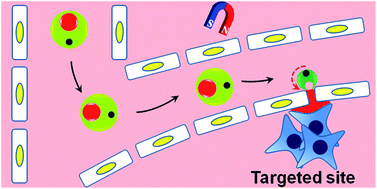Smart microcapsules for direction-specific burst release of hydrophobic drugs†
Abstract
A novel type of monodisperse dual magnetic and thermo-responsive microcapsule, which is composed of a thermo-responsive microgel shell and an eccentric magnetic core as well as an eccentric oil core, is developed for site-specific targeted delivery and direction-specific controlled release of hydrophobic substances. The microcapsules are fabricated with microfluidic-prepared quadruple-component (oil 1 + oil 2)-in-water-in-oil ((O1 + O2)/W/O) double emulsions as templates. The poly(N-isopropylacrylamide) (PNIPAM) microgel shell of the microcapsule can protect the encapsulated hydrophobic drugs at temperatures lower than the lower critical solution temperature (LCST), and achieve the burst release of drugs when the environmental temperature is increased higher than the LCST. The eccentric oil core provides a large inner volume for encapsulation of hydrophobic drug molecules, while the eccentric magnetic core makes the microcapsule able to achieve not only magnetically-guided translational movement for site-specific targeting but also magnetically-guided rotational motion for direction-specific controlled release. The results show that the microcapsules are efficient carriers for site-specific targeted delivery and direction-specific burst release of hydrophobic substances. For the first time our novel microcapsules enable precise “aiming” before “firing”, which is highly desired but was unavailable before.


 Please wait while we load your content...
Please wait while we load your content...